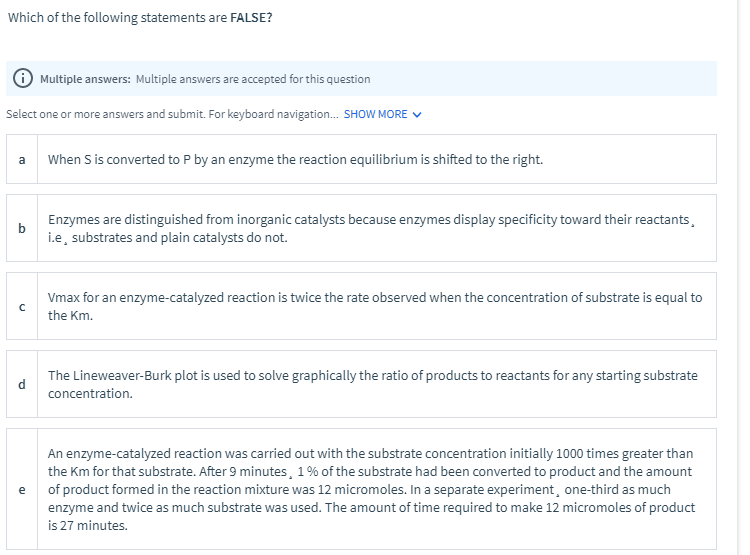Which of the following statements are FALSE?
Discipline: Chemistry
Type of Paper: Question-Answer
Academic Level: Undergrad. (yrs 3-4)
Paper Format: APA
Question

Expert Answer
#(a): An enzyme catalyst only helps to reach the equilibrium faster without disturbing the equilibrium cosntant. Since equilibrium constant remains same, the equilibrium is not shifted by an enzyme. Hence False.
#(b): Enzymes are special due to their ability to be specific towards a single reactant or substrate due their ability to identify only the substrate that are specific to them. On the other hand this property is not found in a plane inorganic catalyst and substrates. Hence True.
# (c): According to Michaelis-Menten kinetics, the formula for Vmax of an enzyme catalyzed reaction is:
V = Vmax * [S] / (Km + [S]) ----- (1)
where V = observed rate
[S] = Substrate concentration
Given Km = [S] ------ (2)
From equation-(1) and (2), replacing [S] by Km
=> V = Vmax * [S] / (Km + [S])
=> V = Vmax * Km / (Km + Km)
=> V = Vmax * Km / 2Km
=> V = Vmax / 2 [ Km cancels out from numerator and denominator]
Km cancels out from numerator and denominator]
=> Vmax = 2*V
Hence Vmax is twice the rate observed. Hence True.
#(d): Lineweaver-Burk plot of graphical representation of how the reciprocal of reaction rate(1/V) varies with the reciprocal of substrate concentration (1/[S]). The slope of the equation is the ratio of Km and Vmax i.e slope = Km/Vmax. Hence we can find the ratio of product to reactants using the slope of Lineweaver-Burk plot.
Hence True.
#(e): An enzyme helps in reaching the reaction faster. So smaller the enzyme concentration larger is the time required to achieve product. Since on the separate experiment, we have decreased the enzyme concentration by 1/3rd, the time taken to form the same amount of product (12 micromoles) will be 3 times higher.
Hence total time required = 9*3 = 27 minutes.
Hence True
Hence only option (a) is False and rest are True.